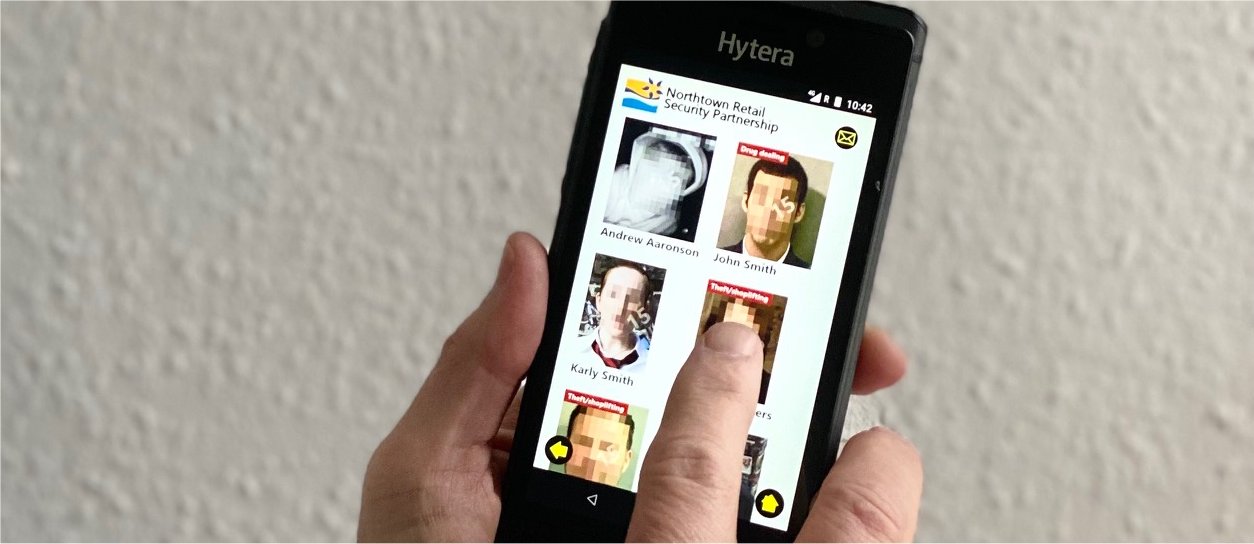A radio revolution for business crime reduction schemes?

Sharing information is a core function of business crime reduction schemes, whether it’s sharing urgent, important information between members, or enabling them to quickly, conveniently access images of local offenders and banned individuals. Now a new generation of radio handsets is set to support both types of communication in one powerful – and affordable – package.
Radio handsets with access to Disc
Some business crime reduction schemes (BCRSs) provide their members with mobile radio systems for sharing urgent, important information. At the same time, across the county, such schemes use Disc to share images of local offenders – as well as news, alerts, access to documents and information about up-coming events – with members on their own personal smartphones.
For some years now many radio handsets have been ‘Android-enabled’ (such as the Hytera device shown above) so they can operate either as radios or as smartphones. The devices increasingly sport smartphone-style large screens. So, like conventional smartphones, they can now display the Disc App.
That means the devices enable users to benefit from participating in local radio schemes – at the same time as providing access to their Disc system to access galleries of local offenders, alerts, news and documents, plus submit incident reports about low-level crime and ASB to their local Disc Administrator. Putting Disc onto the new breed of Android-enabled radio handsets is simple, and means users need only one device.
But setting up radio networks can be costly, and radio handsets can be expensive too. They may make clear economic sense for professional security officers or members who use the devices regularly. But the cost may be more difficult to justify for smaller retailers or licensed premises who use the service only infrequently – and for the BCRSs that support them too. Happily for them, a solution is now available.
Push-to-Talk over Cellular: linking smartphones into radio networks
Push-to-Talk over Cellular (PTToC) changes those economics. Smartphone Apps have offered PTToC – providing many of the functions of conventional radio systems at a fraction of the cost – for many years now. So why is it only now that PTToC has become a viable option?
Use of PTToC by BCRSs has been held back by two factors: patchy internet or mobile phone coverage, and reticence on the part of conventional radio suppliers to promote systems which can be delivered at lower cost – and therefore lower profit.
But mobile phone coverage and access to WiFi is now virtually ubiquitous and robust in all but the most remote rural areas. And some radio suppliers, recognising the potential of PTToC, are moving towards offering PTToC faster than others.
Tom Ross is Managing Director of Foresolutions which has recently supplied a Business Improvement District with a flexible local radio system which links conventional radios with smartphones using PTToC (and delivers access to the BID’s Disc system on both types of devices).
Says Ross: “The options are so much wider and more practical now than they were, even a couple of years ago. And we can be much more flexible about how we can deliver radio-style communications to a BID. So schemes can offer PTToC communications between levy payers who can opt to access the system through their own smartphones or through dedicated radio handsets.
“That means schemes can offer the benefits of a local radio network to a wider range of users – high-volume ones that perhaps can more easily cost-justify dedicated handsets, as well as lighter users who can simply use their existing smartphones. To be able to display Disc on either of them is an important additional benefit”.
Businesses that have to contend with high volumes of low-level crime and ASB will likely opt to use dedicated Android-enabled radio handsets; others with only occasional requirements can simply use PTToC on their existing smartphones. And both types of devices can communicate between each other across the same network.
The fact that PTToC systems use the standard internet network means that setting up a radio-type communication scheme doesn’t involve costly aerials and repeaters, and the network itself is not vulnerable to any ‘single point of failure’. “And expanding such a network is also easy” says Ross. “In fact there is no reason why a single PTToC network can’t extend right across the country. So schemes that are keen to extend their areas of coverage can do so without any additional infrastructure costs”.
There are lots of basic PTT apps available for download onto smartphones – many of them free of charge for the non-business user. But few offer advanced functions such as indoor and outdoor location, multiple channels, recorded video calling or group text messaging. Neither do they provide the central control that conventional radio schemes need – for example managing membership of the network, disabling users when necessary, and seeing when users are online and active.
Says Tom Ross: “That’s where providers like ourselves can deliver flexible solutions which make the most of lower-cost PTToC at the same time as ensuring the overall control and management of the system by a BID or business crime reduction scheme”.